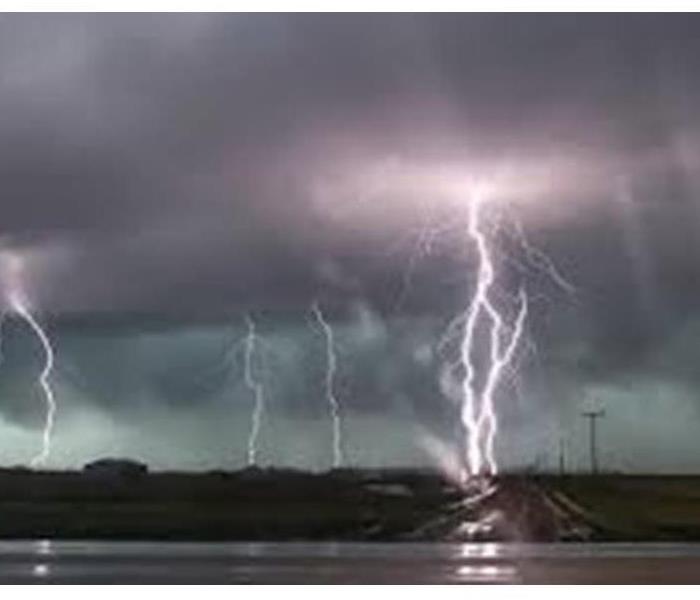STORM SAFETY TIPS:
8/31/2017 (Permalink)
STORM SAFETY TIPS:
Lightning Safety Tips:
- Postpone outdoor activities if thunderstorms are imminent. Lightning can travel 5-10 miles away from the thunderstorm and strike the ground with blue sky overhead. The storm doesn’t have to be overhead in order for you to be struck.
- Move to a sturdy shelter or vehicle. Do not take shelter in a small shed, under isolated trees, or in a convertible-top vehicle. Stay away from tall objects such as trees or towers or poles.
- If in your vehicle when lightning strikes – don’t touch a metal surface. You are safer in a vehicle than being outdoors.
- Remember that utility lines or pipes can carry the electrical current underground or through a building. Avoid electrical appliances, and use telephones or computers only in an emergency.
- If you feel your hair standing on end – get down into a baseball catcher’s position and plug your ears with your finger tips so if lightning does hit it will not blow your ear drums out. Do not lie flat!
- 30/30 rule – if the time between lighting and thunder is 30 seconds or less, go to a safe shelter. Stay there until 30 minutes after the last rumble of thunder.
Flash Flood/Flood Safety Tips:
- Nearly half of all fatalities in a flash flood involve a person driving a vehicle. Do not drive into a flooded area – Turn Around Don’t Drown! It takes only 2 feet of water to float away most cars. It’s amazing how powerful we feel when we get behind the wheel – don’t do it!
- It takes only 6 inches of fast-moving water to sweep a person off their feet – don’t walk through a flooded area!
- If you are camping in a river valley, move to higher ground if thunderstorms with heavy rains are in the area. Do not attempt to drive away.
- Don’t operate electrical tools in flooded areas.
- Most flash flood deaths occur in the middle of the night when it is more difficult to see rising water levels judge the depth of water covering road surfaces.
Severe Thunderstorm Straight-line Winds:
- Don’t underestimate the power of strong thunderstorm winds known as straight-line winds – they can reach speeds of 100 to 150 mph. Hurricane-force winds start at 74 mph. Wisconsin does experience these kinds of winds!
- If a severe thunderstorm warning contains hurricane-force wind speeds seek shelter immediately (as you would for a tornado situation).
- Stay away from windows and go to the basement or interior room/hallway. Do not use electrical appliances.
- Be aware that tall trees near a building can be uprooted by straight-line winds – that tree can come crashing through the roof of a home and crush a person to death.
- Powerful straight-line winds can overturn a vehicle or even make a person air-borne when they get up over 100 mph!
- One type of a straight-line wind event is a downburst, which is a small area of rapidly descending rain-cooled air and rain beneath a thunderstorm. A downburst can cause damage equivalent to a strong tornado!
Large Hail:
- Although it is rare, people have been killed by large hail stones after sustaining head injuries. Additionally, several people are injured by large hail stones each year in the U.S.
- Some thunderstorms can produce large hail stones that can reach the size of baseballs, softballs, or even as big as computer compact discs (CD) or DVDs! These large hail stones can fall at speeds over 100 mph! – that’s why they are dangerous! The largest hail stone in Wisconsin was over 7 inches in diameter!
- If a severe storm is producing large hail stones, seek a sturdy shelter and stay away from windows that can easily be smashed.
- If you are in your vehicle before the hail storm starts, get out of it and go to a sturdy shelter. Glass windows in vehicles can easily be smashed by the hail stones. If you can’t get out of your vehicle, then come to a stop and cover your head with your arms and hands.





 24/7 Emergency Service
24/7 Emergency Service